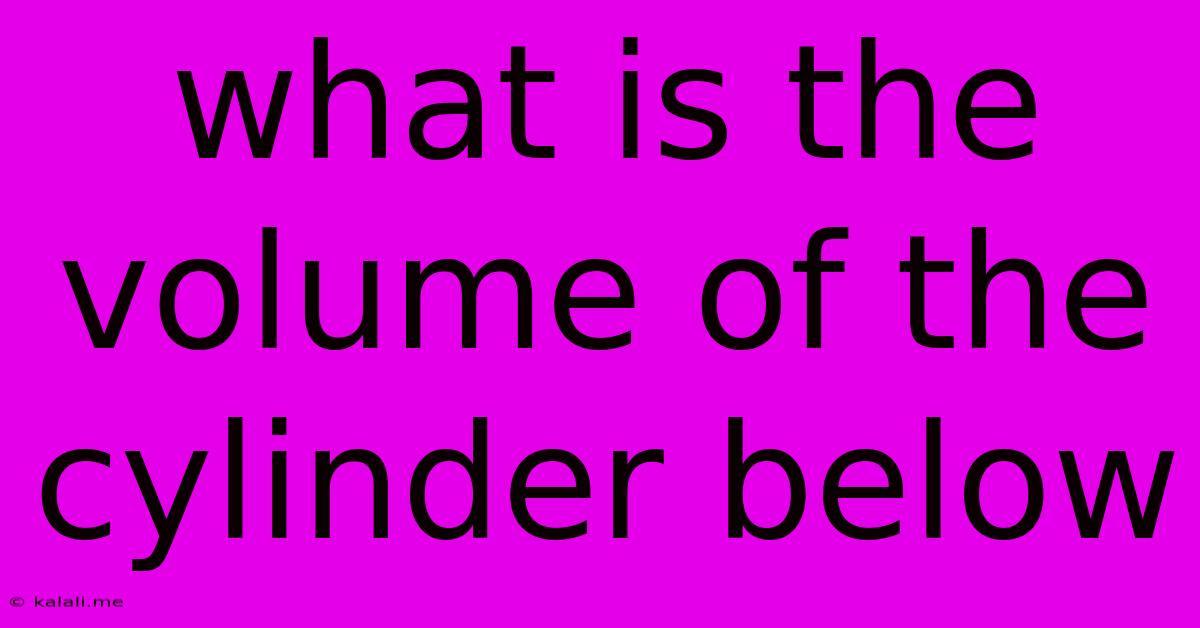What Is The Volume Of The Cylinder Below
Kalali
May 09, 2025 · 3 min read

Table of Contents
Calculating the Volume of a Cylinder: A Step-by-Step Guide
Finding the volume of a cylinder is a fundamental concept in geometry with practical applications in various fields, from engineering to everyday life. This article will guide you through the process of calculating the volume of a cylinder, providing clear explanations and examples. Understanding this calculation is crucial for anyone working with three-dimensional shapes and their properties.
The formula for the volume of a cylinder is straightforward and relies on two key measurements: the radius (or diameter) and the height of the cylinder. Let's break down the formula and how to use it effectively.
Understanding the Formula: V = πr²h
The formula for the volume (V) of a cylinder is: V = πr²h
Where:
- V represents the volume of the cylinder.
- π (pi) is a mathematical constant, approximately equal to 3.14159.
- r represents the radius of the cylinder's circular base. The radius is the distance from the center of the circle to any point on the circumference.
- h represents the height of the cylinder. This is the perpendicular distance between the two circular bases.
Step-by-Step Calculation
To calculate the volume, follow these steps:
-
Identify the radius (r): If you are given the diameter, remember to divide it by 2 to find the radius. (Radius = Diameter / 2)
-
Identify the height (h): This is the straight-line distance between the two circular bases of the cylinder.
-
Square the radius (r²): Multiply the radius by itself (r * r).
-
Multiply by π: Multiply the squared radius by π (approximately 3.14159). Many calculators have a dedicated π button for increased accuracy.
-
Multiply by the height (h): Multiply the result from step 4 by the height of the cylinder.
-
The final result: This final number represents the volume of the cylinder, usually expressed in cubic units (e.g., cubic centimeters, cubic meters, cubic inches).
Example Calculation
Let's say we have a cylinder with a radius of 5 cm and a height of 10 cm. Let's calculate its volume:
- Radius (r): 5 cm
- Height (h): 10 cm
- r²: 5 cm * 5 cm = 25 cm²
- πr²: 3.14159 * 25 cm² ≈ 78.54 cm²
- V = πr²h: 78.54 cm² * 10 cm ≈ 785.4 cm³
Therefore, the volume of the cylinder is approximately 785.4 cubic centimeters.
Important Considerations
- Units: Always ensure you use consistent units throughout your calculations. If the radius is in centimeters, the height should also be in centimeters, resulting in a volume in cubic centimeters.
- Accuracy: The accuracy of your answer depends on the accuracy of your measurements and the value of π you use. Using a calculator's built-in π function generally provides greater precision.
- Real-world applications: Understanding cylinder volume calculations is essential in various real-world scenarios, such as determining the capacity of tanks, pipes, or containers.
By following these steps and understanding the formula, you can confidently calculate the volume of any cylinder, regardless of its size or dimensions. Remember to always double-check your work and ensure consistent units for accurate results.
Latest Posts
Latest Posts
-
What Type Of Organism Utilizes Photosynthesis To Produce Food
May 09, 2025
-
24 Inches Is How Many Centimeters
May 09, 2025
-
What Is 72 Inches In Cm
May 09, 2025
-
3 Celsius Is What In Fahrenheit
May 09, 2025
-
How Many Cups In Two Gallons
May 09, 2025
Related Post
Thank you for visiting our website which covers about What Is The Volume Of The Cylinder Below . We hope the information provided has been useful to you. Feel free to contact us if you have any questions or need further assistance. See you next time and don't miss to bookmark.